
Desert bighorn sheep, male ram. The desert bighorn sheep occupies dry, rocky mountain ranges in the Mojave and Sonoran desert regions of California, Nevada and Mexico. The desert bighorn sheep is highly endangered in the United States, having a population of only about 4000 individuals, and is under survival pressure due to habitat loss, disease, over-hunting, competition with livestock, and human encroachment.
Species: Desert bighorn sheep, Ovis canadensis nelsoni
Image ID: 14672
Species: Desert bighorn sheep, Ovis canadensis nelsoni
Image ID: 14672

Desert bighorn sheep, male ram. The desert bighorn sheep occupies dry, rocky mountain ranges in the Mojave and Sonoran desert regions of California, Nevada and Mexico. The desert bighorn sheep is highly endangered in the United States, having a population of only about 4000 individuals, and is under survival pressure due to habitat loss, disease, over-hunting, competition with livestock, and human encroachment.
Species: Desert bighorn sheep, Ovis canadensis nelsoni
Image ID: 14673
Species: Desert bighorn sheep, Ovis canadensis nelsoni
Image ID: 14673

Desert bighorn sheep, male ram. The desert bighorn sheep occupies dry, rocky mountain ranges in the Mojave and Sonoran desert regions of California, Nevada and Mexico. The desert bighorn sheep is highly endangered in the United States, having a population of only about 4000 individuals, and is under survival pressure due to habitat loss, disease, over-hunting, competition with livestock, and human encroachment.
Species: Desert bighorn sheep, Ovis canadensis nelsoni
Image ID: 14674
Species: Desert bighorn sheep, Ovis canadensis nelsoni
Image ID: 14674

Desert bighorn sheep, male ram. The desert bighorn sheep occupies dry, rocky mountain ranges in the Mojave and Sonoran desert regions of California, Nevada and Mexico. The desert bighorn sheep is highly endangered in the United States, having a population of only about 4000 individuals, and is under survival pressure due to habitat loss, disease, over-hunting, competition with livestock, and human encroachment.
Species: Desert bighorn sheep, Ovis canadensis nelsoni
Image ID: 14675
Species: Desert bighorn sheep, Ovis canadensis nelsoni
Image ID: 14675

Desert bighorn sheep, male ram. The desert bighorn sheep occupies dry, rocky mountain ranges in the Mojave and Sonoran desert regions of California, Nevada and Mexico. The desert bighorn sheep is highly endangered in the United States, having a population of only about 4000 individuals, and is under survival pressure due to habitat loss, disease, over-hunting, competition with livestock, and human encroachment.
Species: Desert bighorn sheep, Ovis canadensis nelsoni
Image ID: 14676
Species: Desert bighorn sheep, Ovis canadensis nelsoni
Image ID: 14676

Juvenile sheephead wrasse.
Species: California sheephead wrasse, Semicossyphus pulcher
Image ID: 14944
Species: California sheephead wrasse, Semicossyphus pulcher
Image ID: 14944

Unidentified marinecrab atop strawberry anemones.
Species: Strawberry anemone, Corynactis californica, Crabbius idontknowus
Image ID: 14956
Species: Strawberry anemone, Corynactis californica, Crabbius idontknowus
Image ID: 14956

Epaulette shark. The epaulette shark is primarily nocturnal, hunting for crabs, worms and invertebrates by crawling across the bottom on its overlarge fins.
Species: Epaulette shark, Hemiscyllium ocellatum
Image ID: 14959
Species: Epaulette shark, Hemiscyllium ocellatum
Image ID: 14959

Epaulette shark. The epaulette shark is primarily nocturnal, hunting for crabs, worms and invertebrates by crawling across the bottom on its overlarge fins.
Species: Epaulette shark, Hemiscyllium ocellatum
Image ID: 14960
Species: Epaulette shark, Hemiscyllium ocellatum
Image ID: 14960
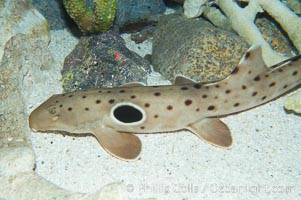
Epaulette shark. The epaulette shark is primarily nocturnal, hunting for crabs, worms and invertebrates by crawling across the bottom on its overlarge fins.
Species: Epaulette shark, Hemiscyllium ocellatum
Image ID: 14961
Species: Epaulette shark, Hemiscyllium ocellatum
Image ID: 14961
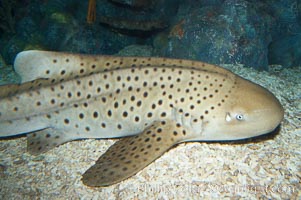
Zebra shark. The zebra shark feeds on mollusks, crabs, shrimps and small fishes. It can reach a length of 10 feet (3m).
Species: Zebra shark, Stegostoma fasciatum
Image ID: 14967
Species: Zebra shark, Stegostoma fasciatum
Image ID: 14967

Zebra shark. The zebra shark feeds on mollusks, crabs, shrimps and small fishes. It can reach a length of 10 feet (3m).
Species: Zebra shark, Stegostoma fasciatum
Image ID: 14968
Species: Zebra shark, Stegostoma fasciatum
Image ID: 14968

Zebra shark. The zebra shark feeds on mollusks, crabs, shrimps and small fishes. It can reach a length of 10 feet (3m).
Species: Zebra shark, Stegostoma fasciatum
Image ID: 14969
Species: Zebra shark, Stegostoma fasciatum
Image ID: 14969

Zebra shark. The zebra shark feeds on mollusks, crabs, shrimps and small fishes. It can reach a length of 10 feet (3m).
Species: Zebra shark, Stegostoma fasciatum
Image ID: 14970
Species: Zebra shark, Stegostoma fasciatum
Image ID: 14970

Zebra shark. The zebra shark feeds on mollusks, crabs, shrimps and small fishes. It can reach a length of 10 feet (3m).
Species: Zebra shark, Stegostoma fasciatum
Image ID: 14971
Species: Zebra shark, Stegostoma fasciatum
Image ID: 14971

Zebra shark. The zebra shark feeds on mollusks, crabs, shrimps and small fishes. It can reach a length of 10 feet (3m).
Species: Zebra shark, Stegostoma fasciatum
Image ID: 14972
Species: Zebra shark, Stegostoma fasciatum
Image ID: 14972

Zebra shark. The zebra shark feeds on mollusks, crabs, shrimps and small fishes. It can reach a length of 10 feet (3m).
Species: Zebra shark, Stegostoma fasciatum
Image ID: 14973
Species: Zebra shark, Stegostoma fasciatum
Image ID: 14973

Zebra shark. The zebra shark feeds on mollusks, crabs, shrimps and small fishes. It can reach a length of 10 feet (3m).
Species: Zebra shark, Stegostoma fasciatum
Image ID: 14974
Species: Zebra shark, Stegostoma fasciatum
Image ID: 14974

Zebra shark. The zebra shark feeds on mollusks, crabs, shrimps and small fishes. It can reach a length of 10 feet (3m).
Species: Zebra shark, Stegostoma fasciatum
Image ID: 14975
Species: Zebra shark, Stegostoma fasciatum
Image ID: 14975

Zebra shark. The zebra shark feeds on mollusks, crabs, shrimps and small fishes. It can reach a length of 10 feet (3m).
Species: Zebra shark, Stegostoma fasciatum
Image ID: 14976
Species: Zebra shark, Stegostoma fasciatum
Image ID: 14976

Zebra shark. The zebra shark feeds on mollusks, crabs, shrimps and small fishes. It can reach a length of 10 feet (3m).
Species: Zebra shark, Stegostoma fasciatum
Image ID: 14977
Species: Zebra shark, Stegostoma fasciatum
Image ID: 14977

Sally lightfoot crab on volcanic rocks, Punta Albemarle.
Species: Sally lightfoot crab, Grapsus grapsus
Location: Isabella Island, Galapagos Islands, Ecuador
Image ID: 16601
Species: Sally lightfoot crab, Grapsus grapsus
Location: Isabella Island, Galapagos Islands, Ecuador
Image ID: 16601
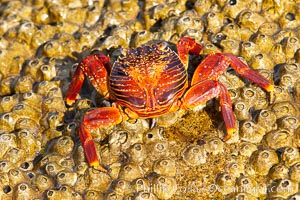
Sally lightfoot crab on barnacles.
Species: Sally lightfoot crab, Grapsus grapsus
Location: North Seymour Island, Galapagos Islands, Ecuador
Image ID: 16602
Species: Sally lightfoot crab, Grapsus grapsus
Location: North Seymour Island, Galapagos Islands, Ecuador
Image ID: 16602

Sally lightfoot crab on volcanic rocks, Punta Albemarle.
Species: Sally lightfoot crab, Grapsus grapsus
Location: Isabella Island, Galapagos Islands, Ecuador
Image ID: 16603
Species: Sally lightfoot crab, Grapsus grapsus
Location: Isabella Island, Galapagos Islands, Ecuador
Image ID: 16603
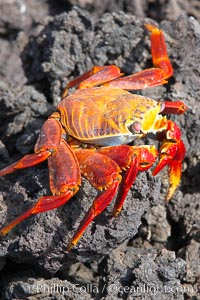
Sally lightfoot crab on volcanic rocks, Punta Albemarle.
Species: Sally lightfoot crab, Grapsus grapsus
Location: Isabella Island, Galapagos Islands, Ecuador
Image ID: 16605
Species: Sally lightfoot crab, Grapsus grapsus
Location: Isabella Island, Galapagos Islands, Ecuador
Image ID: 16605
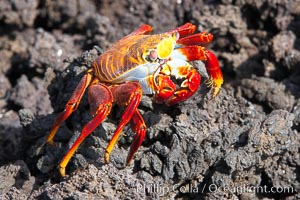
Sally lightfoot crab on volcanic rocks, Punta Albemarle.
Species: Sally lightfoot crab, Grapsus grapsus
Location: Isabella Island, Galapagos Islands, Ecuador
Image ID: 16606
Species: Sally lightfoot crab, Grapsus grapsus
Location: Isabella Island, Galapagos Islands, Ecuador
Image ID: 16606

Christmas anemone, feeds on small crabs, urchins and fish, may live 60 to 80 years.
Species: Christmas anemone, Urticina crassicornis
Image ID: 16965
Species: Christmas anemone, Urticina crassicornis
Image ID: 16965

Christmas anemone, feeds on small crabs, urchins and fish, may live 60 to 80 years.
Species: Christmas anemone, Urticina crassicornis
Image ID: 16966
Species: Christmas anemone, Urticina crassicornis
Image ID: 16966

Christmas anemone, feeds on small crabs, urchins and fish, may live 60 to 80 years.
Species: Christmas anemone, Urticina crassicornis
Image ID: 16967
Species: Christmas anemone, Urticina crassicornis
Image ID: 16967

Christmas anemone, feeds on small crabs, urchins and fish, may live 60 to 80 years.
Species: Christmas anemone, Urticina crassicornis
Image ID: 16971
Species: Christmas anemone, Urticina crassicornis
Image ID: 16971